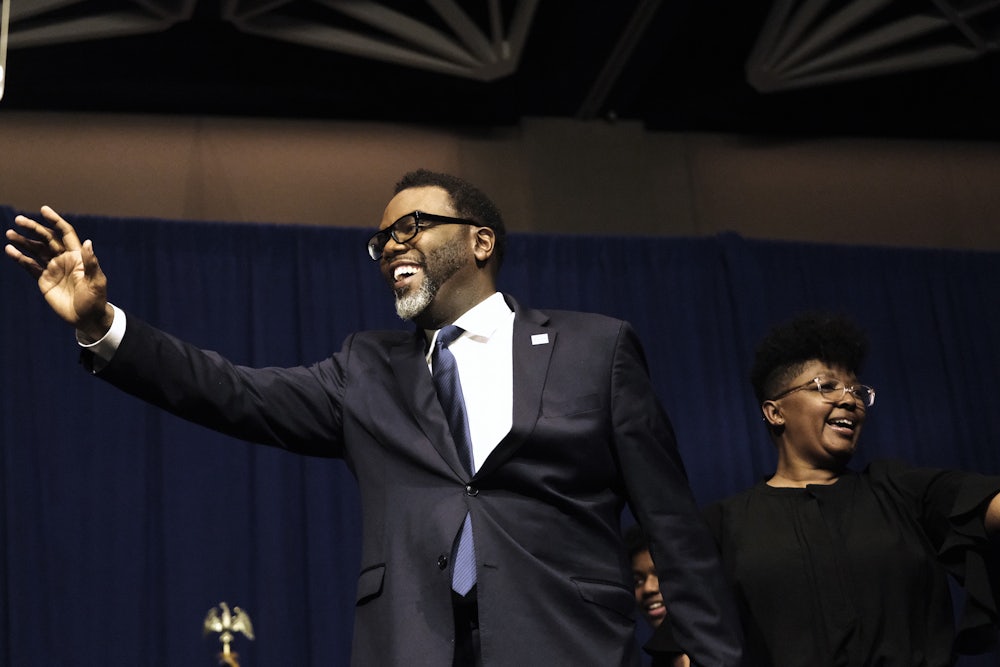Five months after a “red wave” failed to materialize during the 2022 midterm elections, Democrats—and progressives, in particular—keep winning. On Tuesday, Brandon Johnson, a former teacher and union organizer, won the runoff in Chicago’s Democratic mayoral election, besting Paul Vallas, a moderate school superintendent who had flirted with becoming a Republican for years. In Wisconsin, liberal Judge Janet Protasiewicz won a seat on the state Supreme Court over former judge (and crybaby) Dan Kelly, giving the court a liberal majority for the first time in more than a decade.
Though overshadowed by the day’s biggest political news—the arraignment of former President Donald Trump—Johnson’s and Protasiewicz’s victories are significant. For years, mainstream pundits and moderate Democrats have insisted that the party pivot to the center, particularly on issues like crime and inflation, or risk permanently losing swing voters to the Republican Party and consigning the Democrats to minority power. More than halfway through the Biden administration, it’s clear that this argument was wrong. Instead, Democrats have hardly lost momentum—and it’s progressives, not moderates or centrists, who are energizing the party.
Two years ago, Eric Adams declared himself “the face of the Democratic Party.” A former cop, he had just romped to victory in New York City’s Democratic mayoral primary—and de facto general election—on a campaign rooted in moderation. New Yorkers were fed up with the effete, progressive Bill de Blasio, who was ridiculed for much of his time in office. Adams promised not just a return to common sense but a repudiation of recent Democratic politics, which had been dominated by calls for criminal justice reform and protests of police brutality. Adams rejected all that, campaigning more or less exclusively on a platform focused on law and order and cleaning up the streets. When he won, he saw a lesson for his party.
“Look at me, and you’re seeing the future of the Democratic Party,” Adams said. “If the Democratic Party fails to recognize what we did here in New York, they’re going to have a problem in the midterm elections and they’re going to have a problem in the presidential election.” Many Democrats agreed. With inflation and concerns about crime on the rise—and Bernie Sanders’s revolution stalled out—Adams’s election was seen as a blueprint. “Because there was such an intensity of a reaction on the left to [former President Donald] Trump, many in the political ecosystem mistook that for ideological intensity on the left,” former Obama communications director Jennifer Palmieri told the AP. “The same ideological shift on the right—Republicans moving with Trump—did not happen on the left and voters are instead being more pragmatic and less ideological.”
Later that year, Democrat Terry McAuliffe lost Virginia’s gubernatorial election to Republican Glenn Youngkin, who ran a campaign of fearmongering about education and crime—another data point suggesting that Democrats had gone too left and too woke. With the midterms approaching, there was broad anxiety within the Democratic Party that it needed to moderate in a hurry. “Political reality just didn’t support the expansive view of progressive possibilities,” former Clinton administration official Bill Galston said in the summer of 2022. “If you put an ideological template on it, you have to say the correction is to the center.” As summer turned to fall, predictions of a “red wave” election were everywhere.
It never materialized. Instead, Republicans narrowly won a majority in the House of Representatives—falling far short of projections of a 30-seat majority—and did not take the Senate. For months, they had battered Democrats on crime, inflation, and wokeness; it didn’t take. Six months later, it still hasn’t.
In Chicago, Vallas had several clear advantages. He spent twice as much money as Johnson; he was also far better known. At the end of last year, more than two-thirds of Chicago voters had never heard of Brandon Johnson; on Tuesday, they essentially elected him mayor. Vallas only has himself to blame. He leaned too heavily on the Adams playbook. Already open to criticism for his past support for some Republicans, he welcomed support from the right and the GOP, partly as a means of distinguishing himself from the more progressive Johnson. He was endorsed by Chicago’s Republican Party and shared key donors with Betsy DeVos and Trump himself. He embraced Chicago’s Fraternal Order of Police in a practical bear hug—only to attempt to distance himself after they invited Ron DeSantis to speak to them as an honored guest.
What Vallas seemingly forgot to do was remind people that he was a Democrat. Though damaged by a number of past remarks—including one in which he declared himself personally “pro-life”—Vallas made few efforts to engage with median Democrats, instead aggressively pushing education reform and the hiring of hundreds of new police officers. Johnson, meanwhile, made a more artful pivot, distancing himself from a previous flirtation with the “defund the police” movement by pledging to hire more detectives and criticizing Vallas’s past stints as a pro-privatization head of school systems in Chicago, New Orleans, and Philadelphia. It worked: In May, Johnson will be mayor of Chicago. As happened in Los Angeles, when developer—and former Republican—Rick Caruso lost to progressive Karen Bass, running to the right in a Democratic primary is increasingly a recipe for disaster.
In Wisconsin, the situation was simpler. Democrats relentlessly reminded voters that the state’s Supreme Court was set to uphold a ban on abortion that had been on the books since 1849 but only went into effect when the U.S. Supreme Court overturned Roe v. Wade. It worked. Suburban voters, particularly in Milwaukee, abandoned the GOP and supported Protasiewicz. The state’s Supreme Court is now poised to strike down that ban.
For Democrats, there is a lesson here. When they run on protecting abortion rights, they tend to win. When they shy away from messages that are central to their party’s identity—for instance, by tacking to the center with tough-on-crime policies—their record is much more mixed. (Eric Adams’s approval rating, it’s worth noting, is currently 37 percent.) In much of the country, voters don’t want Republican-lite candidates. They want Democrats who act like Democrats.






